Newfoundland
-
- The Path to the Arctic Marine Technology, Jan 2015 #34
When Newfoundland and Labrador is described as the ‘path’ to the Arctic, it is done so using the fullness of the word, from the province’s strategic location to its world-class Arctic-related expertise, infrastructure, and facilities. As Canada’s most easterly province, extending north to the edge of the Arctic, Newfoundland and Labrador is ideally located along international shipping lanes and northern sea routes to connect with markets in the Arctic, Canada, the United States, Central and South America, Europe, and Asia.
Surrounded by the North Atlantic Ocean and uniquely positioned along Iceberg Alley, the waters around Newfoundland and Labrador are colder than anywhere else in the world with temperatures south of 60 degrees – colder than waters near Norway and in parts of Alaska, Greenland and Iceland. While the water isn’t technically ‘in the Arctic,’ the existing conditions are Arctic in nature, providing a unique place to develop solutions to arctic challenges.
Newfoundland and Labrador is self-described as the world’s cold ocean laboratory, with a vibrant ocean technology sector providing global guidance on all matters Arctic. It is also home to growing sectors such as oil and gas, shipping, education and training, and research and development, as well as traditional sectors such as mining and commercial fisheries.
Newfoundland and Labrador boasts a rich history of ocean exploration and adventure. When Robert Peary set out to explore the Arctic more than 100 years ago, it was a Newfoundlander he approached to assist him. Brigus-born master mariner Captain Bob Bartlett became Peary’s first mate for three Arctic expeditions. Even back then, Newfoundland and Labrador was heralded as a natural path to the Arctic and home to the world’s foremost experts when it came to operating in cold, harsh and ice-prone environments.
Arctic Innovation is in their DNA
Generations of the province’s hardy people have been raised and nourished by the sea. For countless years, fishing was vital with entire communities sustained by the cold ocean bounty. Along the way, many lessons were learned, respect was earned, and innovations were conceived to make the next saltwater sojourn safer and more efficient.
In time, a new sea-bound bounty began to reveal itself on and off the shore. As abundant as the water was with sea life, so the land and seabed proved to be with natural resources, metals, and minerals.
Onshore, a mining industry has boomed, particularly in Labrador, where mining operations have been ongoing for more than half a century. Today, mining is a multi-billion dollar industry producing nearly half of Canada’s iron ore, and more than 10% of its overall mineral production.
Now synonymous with offshore oil and gas operations, Newfoundland and Labrador produces more than 80% of Canada’s offshore petroleum and one-third of its light crude. At the base of this operation is the Hibernia gravity base structure, the concrete foundation of which was the first in the world designed to resist the impact of sea ice and icebergs.
Newfoundland and Labrador is home to Canada’s deepest oil well, reaching down some 2.6 km. It is this potential for future growth, coupled with vast experience, inherent innovation, industrial infrastructure, and world-renowned expertise in the oil and gas sector that ideally positions Newfoundland and Labrador for future development in the Arctic.
From this solid base, a cluster of companies, academic institutions, and research and development organizations have emerged, and they strive to push the envelope in cold ocean exploration, from sub-sea imaging and radar technology, to aerial and satellite ice management.
Central to this burgeoning brain trust and array of cutting-edge technology is Memorial University, which has its main campus in the provincial capital of St. John’s. Memorial, and its Fisheries and Marine Institute (Marine Institute, or MI for short), is a key player within the province’s ocean technology cluster, and like its many partners and collaborators in the province, it is casting a keen eye northwards.
“The Arctic is one of the last natural frontiers,” said Memorial University’s Dr. Claude Daley, of the Faculty of Engineering and Applied Science.
“We’re trying to learn the lessons from research rather than having to learn them by error in the field. We’re certainly at the cutting edge of what is happening in the world and we are setting the agenda for Arctic and ice research.”
The Marine Institute has the technology to match the expertise, boasting the largest collection of marine simulators in North America. Its iconic Full Mission Ship’s Bridge Simulator, a 30-ton ship structure mounted on a hydraulic base in a surround theatre, provides the ability to accurately simulate the sea conditions of anywhere in the world when testing models. MI has sixteen simulators at its disposal, including a new engine room simulator, a tug simulator, ballast control simulators, and small vessel simulators through VMT (Virtual Marine Technology), a local simulation company. A seventeenth is soon to be added in the shape of a deepwater anchor handler simulator.
MI is training the next wave of ocean experts through the School of Ocean Technology and the Center for Applied Ocean Technology. These schools are committed to developing and delivering technology as well as education and training programs to meet the needs of the ocean sector -- all while collaborating with industry in the application of this technology.
Across campus, C-CORE (The Center for Cold Oceans Resource Engineering) and the National Research Council (NRC) also have a key presence in the province’s ocean technology cluster.
Established in 1975 as a partnership between Memorial University and the oil and gas industry, C-CORE has become internationally recognized for its in-depth knowledge and expertise regarding the behavior and prevalence of sea ice and icebergs in regions where future development may occur, as well as for developing techniques to mitigate risk through satellite-based ice monitoring and physical management of ice.
C-CORE maintains a close and synergistic relationship with Memorial University, fostering effective collaboration on a number of levels, particularly in the creation of a vibrant talent pool, with students able to access leading-edge facilities and resources.
Within C-CORE are two centers of excellence dedicated directly to the Arctic.
The first, CARD (Center for Arctic Resource Development) is the only independent, industry-guided research and development initiative in Canada dedicated to responsible, cost-effective hydrocarbon development in Arctic regions. The second, LOOKNorth (Leading Operational Observations and Knowledge for the North) is a national center of excellence with a focus on remote sensing technology in support of northern resource development, and assists technology companies across Canada - especially in Newfoundland and Labrador - in demonstrating the utility of their creations.
Also located on the campus of Memorial University is the Ocean, Coastal and River Engineering (OCRE) division of the almost-century old National Research Council of Canada (NRC). NRC-OCRE offers specialized consulting and applied research services in ocean and coastal engineering, water resources management, marine safety, and marine renewable energy technology, particularly for industries operating in harsh environments, supporting clients in offshore oil and gas, marine transportation, and other sectors. They achieve this through a successful combination of world-class expertise, equipment, and facilities, having made substantial investment in the world’s longest ice tank, a tow tank, and an offshore engineering basin, along with numerical and model testing systems.
“Without these facilities you can’t really play in this area,” said NRC-OCRE’s Director of Research and Development, Jim Millan. It is the price of entry into world-class research, but just as important is having the experts to effectively utilize the technology.”
“This expertise is very specialized and expensive to develop,” said Millan. “It isn’t about just bricks and mortar, it’s about learning how to use the equipment, then going into the field and validating against what you do in the tanks.”
As NRC-OCRE General Manager Terry Lindstrom explains, one of their key focuses is OCRE’s Arctic program.
“We have been spending time, money and energy to physically go into the Arctic, to sample the properties of the ice so we can come back here and replicate it in the tank,” says Lindstrom. “We have to stay relative to the changing environment. If you’re going to design a structure for a harsh environment, you need to understand what that environment is capable of.”
Oceanic Consulting Limited (Oceanic) is itself a leader in commercial marine research and development and provides a portal to marine research facilities in Newfoundland and Labrador. Oceanic delivers a broad and sophisticated range of engineering and consulting services in ocean and Arctic engineering.
In 2014, experts from Newfoundland and Labrador – specifically, Kraken Sonar Systems Inc. – were among those invited to be part of a historic search to locate the lost ships of Captain Sir John Franklin’s ill-fated Arctic Expedition of 1845. Based in Conception Bay South, NL, Kraken is a developer of Synthetic Aperture Sonar (SAS) and the AquaPix system. Kraken’s technology is able to provide ultra-high resolution seabed imaging over long ranges. The company has also created designs that allow for real-time processing and an effective method of removable data storage.
With these institutions and dynamic technology startups keeping tabs on the ocean surface and the depths below, the eyes in the province’s skies come largely courtesy of Provincial Aerospace (PAL). PAL has been flying maritime surveillance aircraft for more than 35 years for government, military and industrial clientele.
PAL’s evolution in the 1980s from simple visual surveillance to advanced ice management methods owed much to the forward thinking of a PAL owner, Gus Ollerhead, who first had the vision to put an anti-submarine radar on an aircraft, something that had never been attempted before.
“Radars designed to pick up periscopes in the Cold War happened to be very effective for picking up ice and icebergs too,” said Jake Trainor, COO, PAL.
This insight set in motion an avalanche of innovation from the company, including a computerized mission management system that not only runs the radar, but also collect the data and provide back-end analysis against reams of historical data, through which analytical and predictive models can be built.
Promoting the Solutions
This abundance of activity and expertise in the province has led to the emergence of multiple associations and cluster organizations to help foster synergy between the various players. Founded in 1977, NOIA (Newfoundland and Labrador Oil and Gas Industries Association) is the largest oil and gas industry association in Canada. Its mission is to promote development of Canada’s east coast hydrocarbon resources and facilitate the participation of its more than 600 members in global oil and gas industries.
OceansAdvance was originally established in 2005 and is the voice of the Newfoundland and Labrador ocean technology innovation cluster. Its members include more than 50 export-driven companies; more than 20 research and technology organizations; as well as highly engaged municipal, provincial and federal governments; plus a number of post-secondary academic institutions and trade associations focused on producing the next generation of ocean leaders. This multi-stakeholder technology cluster is underpinned by innovation, commercialization and export, influenced by Newfoundland and Labrador’s burgeoning offshore energy, transportation, fishing and aquaculture sectors.
Aerospace advocacy comes courtesy of ADIANL (Aerospace and Defense Industry Association of Newfoundland & Labarador). Established in 2001, ADIANL is now nearly 40 members strong. It seeks to identify opportunities for the outstanding aerospace technologies and expertise in the province, particularly related to harsh environments and emerging Arctic requirements.
Partnership and collaboration with Aboriginal peoples and northern communities also plays a critical role in Newfoundland and Labrador’s Arctic endeavors.
Their expansive traditional knowledge and expertise will be invaluable as opportunities in the Arctic are further explored and developed. Forging partnerships and sustaining economic growth in the north, enabling these communities to thrive, is of paramount importance, and the Nunatsiavut Government is already at the table as a key partner in the Province’s Arctic Opportunities Initiative.
This initiative is indicative of the high priority the Government of Newfoundland and Labrador has placed on facilitating the province’s strong and undeniable trajectory as a landmark location for Arctic opportunities. Through its Arctic Opportunities Initiative, Provincial Government is working with stakeholders to explore areas of opportunity; facilitate relationships and partnerships; demonstrate Newfoundland and Labrador as the path to the Arctic; build capacity; and foster economic growth and business opportunities.
The Arctic Opportunities Initiative seeks to create a collaborative environment conducive to stakeholder success, where northern and Aboriginal communities can thrive and benefit, and that will further attract global industry leaders.(As published in the January/February 2015 edition of Marine Technology Reporter - http://www.marinetechnologynews.com/Magazine)
-
- Newfoundland Headed For Major Economic Advances In 1980s Maritime Reporter, Sep 15, 1978 #9
industry expected to triple in size, huge mineral deposits, and extensive hydro-power potential, "the 1980s will be the decade that belongs to Newfoundland and Labrador," according to a new publication, "Newfoundland Opportunity." The 16-page color publication, issued by the provincial Department of
-
- Newfoundland's Ocean Cargo Services Seen Expanding With Coming Offshore Oil Boom Maritime Reporter, Dec 15, 1981 #24
Newfoundland's c o m i n g offshore oil boom will trigger a parallel growth in the province's maritime and air transportation services, the Hon. Neil Windsor, Newfoundland's minister of development, recently told members of the Executives Club of Chicago. Already two o c e a n c a r r i e rs serving
-
- $55.6-Million Arctic Research Center To Be Built In Newfoundland Maritime Reporter, Oct 1981 #78
A $55.6-million maritime research center is under construction at St. John's, Newfoundland. Named the Arctic Vessel and Marine Research Institute, the center has the potential to make research contributions to the offshore industry. Studies concerned with oil production, vessel performance, and cold
-
- $400 Million To Be Spent On Newfoundland Offshore Oil Drilling This Year Maritime Reporter, Aug 1981 #35
The Honorable Neil Windsor, Newfoundland's Minister of Development, recently reported that $400 million will be spent in drilling for oil off the coast of his Canadian province this year, and that oil production should begin by 1987. Noting that Mobil's Hibernia find alone contains 1.85 billion barr
-
- Upgraded Facilities Dedicated At Newfoundland Dockyard Maritime Reporter, Dec 15, 1983 #6
A major modernization and expansion of ship repair facilities at the Newfoundland Dockyard in St. John's was officially opened recently by Premier Brian Peckford. Begun in late 1981, the project was completed slightly ahead of schedule. The upgraded facilities will enable the yard, which is operated
-
- Newfoundland's Windsor Cites $93 Million In New Projects Maritime Reporter, Dec 15, 1983 #34
In a recent speech before the New York Rotary Club, Neil Windsor, Minister of Development for Newfoundland, described some developments representing $93 million in new maritime-related investments in his Canadian province. Mr. Windsor, whose province is approaching a North Sea size offshore oil boom
-
- Icebreaker/Passenger Ferry To Be Built By Marystown Yard In Newfoundland Maritime Reporter, Mar 1991 #8
This spring, Marystown Shipyard in Newfoundland is expected to start construction of a combined icebreaker and passenger ferry, with backing from Swedish icebreaking expertise. The provincial Department of Works, Services and Transportation ordered the $20 million vessel to link Fogo Island off the
-
- Newfoundland-Sweden New Joint Venture Company Maritime Reporter, Aug 1986 #40
In order to meet the long-term needs of the petroleum industry more effectively and provide a broader service base, SeaForest Holdings Limited of Newfoundland, through its subsidiary, NORDCO Limited of St. John's, and Gotaverken Arendal Canada Ltd., a subsidiary of Gotaverken Arendal AB of Sweden
-
- Newfoundland Makes Bid For $.75-Billion Investment In Fishery Maritime Reporter, Oct 15, 1978 #57
Meeting the opportunities opened up by the 200-mile fishing limit will require a three-quarters of a billion-dollar investment in the Newfoundland fishery over the next 10 years. This was the bottom-line assessment made by the Newfoundland Department of Industrial Development, St. John's
-
- $46.8-Million Research Facility To Be Built In St. John's, Newfoundland Maritime Reporter, May 15, 1980 #40
Newfoundland's Premier Brian Peckford has announced that the National Research Council of Canada has given final approval for the construction in St. John's of a $46.8-million marine research institute that will accelerate the Province's promising offshore oil potential. Calling the institute "a
-
- Newfoundland and Labrador: Sensing Success Marine Technology, Mar 2015 #63
Newfoundland and Labrador companies push forward on remote sensing tech Newfoundland and Labrador (NL) is home to a number of companies at the cutting edge of remote sensing technology. From mature, established organizations to specialty start-ups, the province is increasingly excelling in this high
-
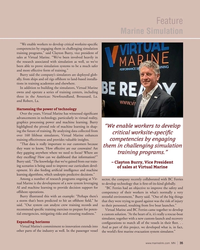 )
February 2024 - Marine News page: 35
)
February 2024 - Marine News page: 35and elsewhere. In addition to building the simulators, Virtual Marine owns and operate a series of training centers, including three in the Americas: Newfoundland, Broussard, La. and Robert, La. Harnessing the power of technology Over the years, Virtual Marine has witnessed signi? cant advancements in technology
-
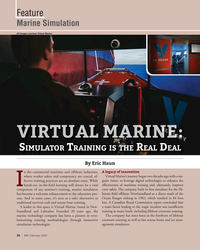 )
February 2024 - Marine News page: 34
)
February 2024 - Marine News page: 34simulation crew safety. The company built its ? rst simulator for the Hi- has become a welcome enhancement to the education pro- bernia ? eld offshore Newfoundland as a direct result of the cess. And in some cases, it’s seen as a safer alternative to Ocean Ranger sinking in 1982, which resulted in 84 lives
-
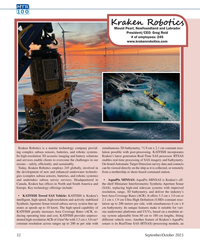 )
September 2023 - Marine Technology Reporter page: 32
)
September 2023 - Marine Technology Reporter page: 32MTR 100 Kraken Robo ics Mount Pearl, Newfoundland and Labrador President/CEO: Greg Reid # of employees: 245 www.krakenrobotics.com Kraken Robotics is a marine technology company provid- simultaneous 3D bathymetry. *1.9 cm x 2.1 cm constant reso- ing complex subsea sensors, batteries, and robotic systems.
-
 )
July 2023 - Marine Technology Reporter page: 41
)
July 2023 - Marine Technology Reporter page: 41with teachers and students on board. a contract from the Memorial University of The oceanographic research vessel stands out for the wide range of en- Newfoundland to supply an electric observation- ergy savings technologies and low-consumption solutions implemented: class remotely operated vehicle (ROV) to
-
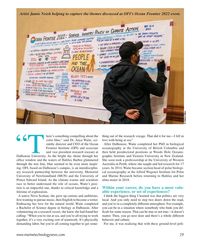 )
March 2023 - Marine Technology Reporter page: 29
)
March 2023 - Marine Technology Reporter page: 29of polar biologi- ary research partnership between the university, Memorial cal oceanography at the Alfred Wegener Institute for Polar University of Newfoundland (MUN) and the University of and Marine Research before returning to Halifax and her Prince Edward Island. As the climate warms and scientists
-
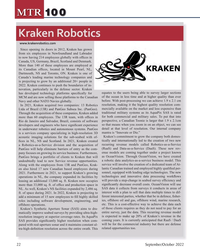 )
September 2022 - Marine Technology Reporter page: 22
)
September 2022 - Marine Technology Reporter page: 22MTR 100 Kraken Robotics www.krakenrobotics.com Since opening its doors in 2012, Kraken has grown from six employees in Newfoundland and Labrador to now having 214 employees globally with of? ces in Canada, US, Germany, Brazil, Scotland and Denmark. More than 140 of these employees are employed at its
-
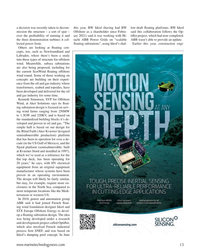 )
January 2022 - Marine Technology Reporter page: 13
)
January 2022 - Marine Technology Reporter page: 13power from. ? oating substations”, using Ideol’s shal- Earlier this year, construction engi- Others are looking at ? oating con- cepts, too, such as Newfoundland and Labrador, where there’s been a study into these types of structure for offshore wind. Meanwhile, subsea substations are also being proposed
-
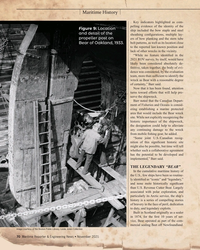 )
November 2021 - Maritime Reporter and Engineering News page: 70
)
November 2021 - Maritime Reporter and Engineering News page: 70. Built in Scotland originally as a sealer in 1874, for the ? rst 10 years of ser- vice, Bear operated as part of the com- mercial sealing ? eet off Newfoundland. Image courtesy of the Boston Public Library, Leslie Jones Collection 70 Maritime Reporter & Engineering News • November 2021 MR #11 (66-74)
-
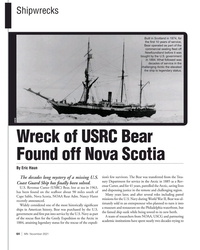 )
November 2021 - Marine News page: 64
)
November 2021 - Marine News page: 64Shipwrecks Built in Scotland in 1874, for the ? rst 10 years of service, Bear operated as part of the commercial sealing ? eet off Newfoundland before it was bought by the U.S. government in 1884. What followed was decades of service in the challenging Arctic the elevated the ship to legendary
-
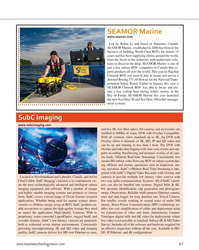 )
September 2021 - Marine Technology Reporter page: 67
)
September 2021 - Marine Technology Reporter page: 67as inspection, sur- vey, and more. SubC’s Offshore Real-Time Streaming is inte- grated with SubC’s Digital Video Recorder with Overlay and Located in Newfoundland and Labrador, Canada, and led by cameras to provide multiple low-latency video sources with Chad Collett, SubC Imaging’s mission is to continuously
-
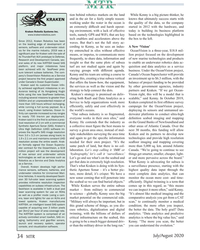 )
July 2020 - Marine Technology Reporter page: 34
)
July 2020 - Marine Technology Reporter page: 34de? nition seabed imaging and mapping Kraken said it is the ? rst to achieve a prac- Kenny. He contends that the industry as on the Grand Banks of Newfoundland and tical resolution of 2 cm with a commercial Synthetic Aperture Sonar (SAS). Kraken’s a collective must ? gure the best means to other areas
-
 )
March 2020 - Marine Technology Reporter page: 64
)
March 2020 - Marine Technology Reporter page: 64. . . . . . . . . . . . . . . .www.falmouth.com . . . . . . . . . . . . . . . . . . . . . . . . . . . . . . . . .(508) 564-7640 32-33 . . .Government of Newfoundland & Labrador . . . .www.findnewfoundlandlabrador.com . . . . . . . . . . . . . . . . .Please visit us online 39 . . . . .HydroComp, Inc. . . . .
-
 )
March 2020 - Marine Technology Reporter page: 32
)
March 2020 - Marine Technology Reporter page: 32Rich in ingenuity and entrepreneurial spirit, Newfoundland and Labrador is uniquely rovb?om;7|oruo?b7;o1;-mbmmo?-?om-m7_-uv_;m?buoml;m|vo???omvl (bvb|?v-||_;-m-7b-m-?b?bom-|1;-mo?o]?m|;um-?om-?ƒ?ƒ?k om7omkm]?-m7?"|-m7??????? Advanced Underwater 3D Subsea Seabed Intelligence Sounding Out Risk Unrivaled
-
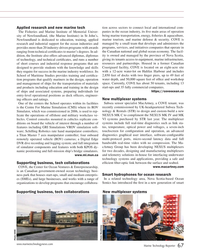 )
July 2019 - Marine Technology Reporter page: 67
)
July 2019 - Marine Technology Reporter page: 67and new marine tech The Fisheries and Marine Institute of Memorial Univer- panies in the ocean industry, its ? ve main areas of operation sity of Newfoundland, (the Marine Institute) in St John’s, being marine transportation, energy, ? sheries & aquaculture, Newfoundland is dedicated to education, training
-
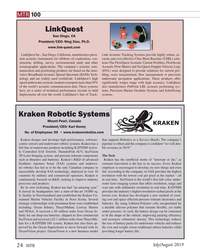 )
July 2019 - Marine Technology Reporter page: 24
)
July 2019 - Marine Technology Reporter page: 24. KATFISH It moved its headquarters into a state-of-the-art 19,000 sq. provides the industry’s highest resolution seabed pixels at the ft. facility in Newfoundland and established the Kraken Un- lowest cost. Kraken has developed a new method of creat- manned Marine Vehicles Facility in Nova Scotia. Several
-
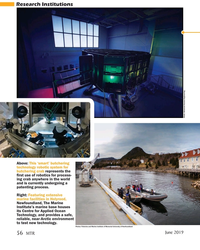 )
June 2019 - Marine Technology Reporter page: 56
)
June 2019 - Marine Technology Reporter page: 56process- ing crab anywhere in the world and is currently undergoing a patenting process. Right: Featuring extensive marine facilities in Holyrood, Newfoundland, The Marine Institute’s marine base houses its Centre for Applied Ocean Technology, and provides a safe, reliable, near-Arctic environment to
-
 )
June 2019 - Marine Technology Reporter page: 55
)
June 2019 - Marine Technology Reporter page: 55Icebreaker design research is carried out in the ice tank at the Marine Institute, St John’s, Newfoundland. The Marine Institute’s Centre for Sustainable Aquatic Resources works with ? sheries around the world using a combination of numerical simulation, physical modeling in its ? ume tank, and
-
 )
June 2019 - Marine Technology Reporter page: 54
)
June 2019 - Marine Technology Reporter page: 54Research Institutions Marine Institute of Memorial University of Newfoundland At the Forefront of Ocean Technology Photo: Tom Mulligan World-class facilities, research and education at the Fisheries and Marine Institute of Memorial University of Newfoundland By Tom Mulligan he Marine Institute or
-
 )
June 2019 - Marine Technology Reporter page: 29
)
June 2019 - Marine Technology Reporter page: 29? oat- technology hubs in Atlantic Canada (Canada’s four eastern- ing hotel/survey vessels shepherding around a precious sonar most provinces including Newfoundland and Labrador, Nova head about the size of a dinner plate. To be clear, that’s exactly Scotia, Prince Edward Island and New Brunswick) and, there-
-
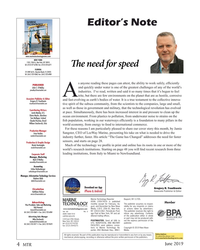 )
June 2019 - Marine Technology Reporter page: 4
)
June 2019 - Marine Technology Reporter page: 4.com world’s research institutions. Starting on page 48 you will ? nd recent research from three leading institutions, from Italy to Miami to Newfoundland. Corporate Staff Manager, Marketing Mark O’Malley [email protected] Accounting Esther Rothenberger [email protected] Manager,
-
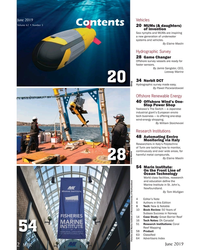 )
June 2019 - Marine Technology Reporter page: 2
)
June 2019 - Marine Technology Reporter page: 2Institute: On the Front Line of Ocean Technology World class facilities, reasearch and education de? ne the Marine Institute in St. John’s, Newfoundland. By Tom Mulligan 4 Editor’s Note 6 Authors in this Edition 8 Tech: New & Notable 10 Book Review: 50 Years of Subsea Success in Norway 14 Case
-
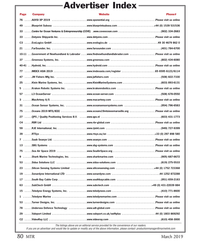 )
March 2019 - Marine Technology Reporter page: 80
)
March 2019 - Marine Technology Reporter page: 80. . . . . . . . . . . . . . . .www.farsounder.com . . . . . . . . . . . . . . . . . . . . . . . . . . . . . . . .(401) 784-6700 10-11 . . .Government of Newfoundland & Labrador . . . .www.findnewfoundlandlabrador.com . . . . . . . . . . . . . . . . .Please visit us online 37 . . . . .Greensea Systems, Inc. .
-
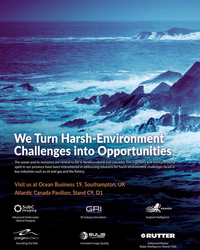 )
March 2019 - Marine Technology Reporter page: 10
)
March 2019 - Marine Technology Reporter page: 10The ocean and its resources are central to life in Newfoundland and Labrador. The ingenuity and entrepreneurial spirit in our province have been instrumental in addressing solutions for harsh-environment challenges faced in key industries such as oil and gas and the fshery. Visit us at Ocean Business 19
-
 )
January 2019 - Marine Technology Reporter page: 64
)
January 2019 - Marine Technology Reporter page: 64Dynamics Mission Systems . . . . . . . . .www.gdmissionsystems.com/bluefin-9.com . . . . . . . . . . . . . . .(617) 715-7000 32-33 . . .Government of Newfoundland & Labrador . . . .www.findnewfoundlandlabrador.com . . . . . . . . . . . . . . . . .Please visit us online 1 . . . . . .Greensea Systems, Inc.
